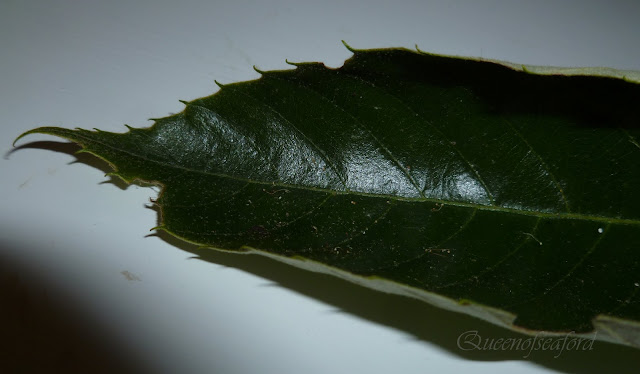These are two different trees. Both are part of the Celtis genus. Similar trees in many ways. This is a tale of two trees.
A couple years ago I went on a Master Gardener study trip with my Virginia MG group. I am still using photos and information learned from that trip. Many trees were identified and photographed. Hackberry, Celtis occidentalis, another native tree, new to me at the time.
The hackberry's bark is ridged with corky spurs or warts, especially on more mature trees. A mature tree will reach heights from 60 to 130 feet. Interestingly it has a growth spurt between 20 to 40 years, living on average 150- 200 years.
The native range of this tree is the eastern United States, south into the mountains of North Carolina with some reported spots in Alabama and Mississippi, west to the Dakotas, Nebraska, Colorado, and some parts of northern Texas.
The alternate leaves on the Hackberry are ovate with serrated margins. They are glossy green and roughly textured.
Interesting, this tree is polygamo-monoecious. What is that??? All types of flowers are on this tree, male flowers, female flowers, and perfect flowers (containing both male and female parts). An insignificant bloom occurs in the spring and berries form. This berry is a food source for many birds and small mammals. It is both a nectar and larval host plant for a number of butterflies, Mourning Cloak, Wild Cherry Sphinx, and Question Mark, to name a few. The fruit ripens to a dark reddish purple. It is edible and sweet, but apparently the seed inside is really hard and can break your tooth should you bite into the fruit.
The fall color is a muddy yellow. The stems have a characteristic zig-zag growth pattern. The stems have prominent lenticels (pores on the stems where gases are exchanged). These trees are tolerant to various growing conditions, but prefer evenly moist soils. It is listed as a good urban tree.
The wood is used for furniture and mill work. Poorer quality wood is used for crates.
-.-.-.-.-.-.-.-.-.-.-.-.-.-.-.-.-.-.-.-.-.-.-.-.-.-.-.-.-.-.-.-.-.-.-.-.-.-.-.-.-.-.-.-.-.-.-.-.-.-.
Fast forward to my woods out front. New location, lots to explore as many of you readers know. I come across a small, somewhat hidden tree. Smooth bark, kind of a zig-zag growth pattern.
What piqued my interest in this seemingly uninteresting little tree? These small usual and quite distinctive blooms. Quite small, two petal, fuzzy white blooms. The leaves are ovate to heart shaped, smooth margins.
I kept coming back to this tree, trying to figure out what it was.
None of my books had pictures of this bloom. It is so unique. Surely there was an answer. I finally asked someone and their answer was 'Hackberry'. Wait a minute, I have other photos of Hackberry, the leaves are so different.
The blooms on the Hackberry are also small, like this. VERY much like this. But the leaf margins were so different.
I continued to look. Celtis laevigata, Sugarberry. I believe I found my answer.
Native range of
C. laevigata is southern Viriginia to Kentucky to North Carolina to Florida, west to Oklahoma and Texas. This must be it!! Another common name is Southern Hackberry. Well, there you are. The bark is not necessarily warty like the Hackberry, smoother bark. Yes, mine is very young and is not a good example of what a mature bark would look like.
Moderate to fast growth in the clay soils, found along the flood plains. Short lived, 100 years. Reports say the fruit stays on the tree until mid-winter....mine have disappeared. The wildlife in my area hasn't read the book.
This is a medium sized tree, growing to a maximum size of 80 feet. Both Celtis are deciduous, yellow fall foliage. Sugarberry also have the lenticels and zig-zag twigs.
Small mammals and birds eat the fruit. The Hackberry Emporer butterfly benefits from this tree.
The wood is used as veneer woods as it is a light wood that can take light to medium dark stains quite well. Both trees are prone to nipple gall and mistletoe is a commonly seen parasite in their branches.
My references are
Virginia Tech,
Silvics Manual, and
Wildflower Center.
There is still a chance I am wrong about this mystery tree in my woods. Right now it is a stangle of honeysuckle vines, will keep my eyes peeled next spring for more interesting flowers. Next year I think I will tie a ribbon on one of the branches to make sure I am looking at the right stem later in the season. If YOU know what this is (different from my guess) please let me know. Life is a study of the nature around you.
©Copyright 2012
Janet. All rights reserved. Content created by Janet for
The Queen of Seaford.
 words and photos by Janet,The Queen of Seaford.
words and photos by Janet,The Queen of Seaford.
































































